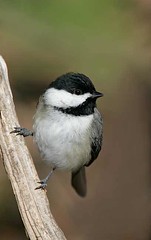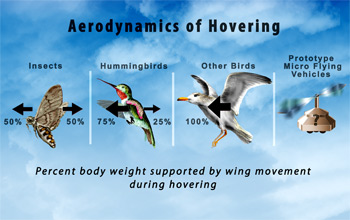Birds in the News #16
Birds Educating People:
 National Public Radio (NPR), which yesterday survived another threat to its continued funding by congress, presents this excellent All Things Considered story about chickadees that would make Doctor Doolittle proud; Chickadee Calls Carry Specifics on Danger. This story, which reports research published in the top-tier journal, Science, by a graduate student at the University of Washington (where I also graduated), includes the streaming NPR news report and three audio files of chickadee alarm calls. Many thanks to four of my pals for these links.
National Public Radio (NPR), which yesterday survived another threat to its continued funding by congress, presents this excellent All Things Considered story about chickadees that would make Doctor Doolittle proud; Chickadee Calls Carry Specifics on Danger. This story, which reports research published in the top-tier journal, Science, by a graduate student at the University of Washington (where I also graduated), includes the streaming NPR news report and three audio files of chickadee alarm calls. Many thanks to four of my pals for these links. Why are people more creative when they are young? Why is it harder to learn as we age? Are we born with an instinct for language? And, provocatively, can we recover lost memories? This story, birds' chirping might provide clues to human learning and memory, shows how birds are helping us answer these questions.

How do hummingbirds hover? In a story that was published in the top-tier journal, Nature, researchers report that hummingbirds hover a bit like bugs (this MSNBC story includes a related hummingbird link). Research co-author Bret Tobalske said, "We were surprised to find that the up stroke in the hovering hummingbird was much less active than the down stroke. This finding provides new insight into evolutionary trends that led to sustained hovering in birds."
Junk food is for kids .. or is it? This research shows that finches given a poor diet briefly in early life become adults that can’t cope with ageing. In Eat Junk, Look Good, Die Young, researchers at Glasgow University found that birds provided a low quality diet for just two weeks grew into adults with much lower levels of antioxidants in their blood, and they found that such birds have shorter lives.
This week at Hilton Pond, two adult Eastern bluebirds, Sialia sialis, were captured in a mist net, and they are the topic for the 8-14 June 2005 photo essay, featuring a closer look at this bluebird pair -- and an intimate view of the female's belly (scroll down on the linked page).
Birds in Movies and on the Web:
March of the Penguins is a new National Geographic and Warner Independent film that tells the tale of emperor penguins, Aptenodytes forsteri, as they struggle to raise their chick during the Antarctic winter. This film is narrated by one of my favorite actors, Morgan Freeman.
This week on BirdNote, the daily 2-minute radio program featured by KPLU/National Public Radio, you can listen to streaming radio stories about the black-bellied plover, California quail, Steller's jay (the mimic), and two stories about George Divoky's research on the Black Guillemots of Cooper Island. There is an archive of all past shows available, along with a photograph accompanying each day's subject.
Ivory-billed Woodpecker News:
The U.S. Fish and Wildlife Service and the Cornell Lab of Ornithology announced new web pages that will help in identifying ivory-billed woodpeckers and in gathering information from the public about potential sightings of this rare bird. The ivory-billed woodpecker, Campephilus principalis, was thought to be extinct for more than 60 years until 28 April 2005, when researchers announced they had rediscovered it.
People Helping Birds:
The Nature Seychelles Reserve received high praise in an international report that evaluated the effectiveness of the management of protected areas in the East Africa and Western Indian Ocean region. Nature Seychelles manages Cousin Island, where many endangered species live and breed, including the Seychelles Warbler, Acrocephalus sechellensis, whose numbers increased from approximately 30 birds in 1968 when the island was purchased as a reserve to more than 300 out of an estimated total global population of just over 2,000.
Where do the endangered Asian vultures go? This recent research is using "vulture restaurants" and satellite technology to pinpoint behaviour of rare vultures. "By fixing satellite transmitters and monitoring vulture movements, we develop a greater understanding of their range size, habitat preferences, and seasonal movements. This increased understanding of ecological parameters allows us to develop more effective, targeted conservation actions and management guidelines," states Dr. Sean Austin, Programme Manager for BirdLife International’s Cambodia Programme Office.
This is a much-needed opinion piece requesting a ban on Delaware Bay horseshoe crab harvests to save the migratory shorebird, the red knot, Calidris canutus, which feeds on them when they stop during migration. The entire population of these birds has plunged to perilous lows, leading scientists to predict extinction of this once-numerous species within ten years. Will public officials agree? Will they do the right thing and ban the horseshoe crab harvests?
Bird Mysteries:
If a city of 28,000 people suddenly abandonded their homes and disappeared, wouldn't that be cause for intense concern and media attention? If you are like me, you will be surprised to learn that last year, 28,000 American white pelicans, Pelecanus erythrorhynchos -- one-third of the North American population -- suddenly abandoned their nests and unhatched eggs at the Chase Lake National Wildlife Refuge in North Dakota and disappeared: Where did they go? Why did they leave? Will they return? No one knows. Why hasn't this event received more media attention?
On small tropical islands, one might think that typhoons are the biggest threat to the bird life, but apparently, this is not true. For example, on Guam, where the native crow population has been declining for 20 years because of snake predation, biologists worried that the recent spate of typhoons would polish off the last few individuals. "But we didn't lose any of the crows and that's just astounding to me," says biologist Bob Beck, the supervisor of Guam's wildlife office. "Did they just hunker to the ground and hang out? We don't know what their adaptations are to typhoons. No one's studied that, and I don't think that I would want to. I'd rather be in a concrete bunker when the winds hit 180 mph."
Previous : : Birds in the News : : Next
No job rejections this week, but also no new job applications. After nearly two years of rejection, I am getting rather sick of it all.
© 2004, 2005, 2006 by GrrlScientist











13 Peer Reviews:
I heard this story about the 'disappearing birds' last year. It is just one more sign that our environment is due for some major and not so nice changes.
Keep the faith, Sister! (about the job search thing, I mean.)
Yay! Those bluebird pics @ Hilton Pond are great! I live not far from there, and I had never heard of the place. Though I can't help but wonder, after looking through their site, how on earth do you catch a hummer and hold it w/out hurting it!?! (not that I intend to try).
Thanks for another great bird post, and 'good luck' with the job search - I think I'm about to get laid off, so I can sort of relate . . .
I had not heard the pelican story before. Leaving nests and eggs is quite a phenomenon. They are like the Anasazi of the bird world. It is shocking that there hasn't been more (anything, for that matter) in the news about it.
Hedwig, a decent number of the errant pelicans did return. For more info, check out my June 22 post on the subject: http://www.10000birds.com/june2005.htm#6/22/05
Reminds me of the question why do hummingbirds hum (because they've forgotten the words).
G.
What about The Wild Parrots of Telegraph Hill?
aloha
psilo
. . . and speaking of NPR and birds, NPR just mentioned a new article in either Science or Nature (can't remember which, can't afford either) about a biologist here in the Carolinas studying the use of corridors to connect fragmented ecosystems due to deforestation, etc.
The results show that corridors work, but the cool thing is, he focused on blue birds and wax myrtles (I think, t-storms kept cutting the signal), and they dyed the berries fluorescent, so they could track the feces of the birds to document their travel. Wow! Glow in the dark bird poo! God I can't wait till I finish school so I can do things like that . . .
Hey Hedwig-- No new posts lately, not even a weekly roundup of Bird News. What's up? Just checking.
I am hoping that no posting means your life is rich, full and busy.
Yeah, me too, even though it could just as well mean that she's so swamped by hard, pittance-paying work she can't post, or that her former employer cut her off.
You don't have to wait to finish school to do stuff like that. We do things like investigate our native birds all the time.
I live on 22.6 acres in SE IN and we have recreated a grassland, baby forest, let our mature forest go, and provide food, shelter and nesting sites for all our birds all year long.
We have so far this year these babies: green heron, blackbird, blue bird, barn swallow, blue jay, crow, cardinal, cowbird, chipping sparrow, tree swallow, house finch, gold finch, eastern phoebe, eastern pewee, red shouldered hawk, common grackles, indigo buntings, chickadees, titmouse (mice, he he he), red bellied woodpecker, downy woodpecker, hairy woodpecker, and soon to arrive... pileated woodpecker and hummingbird babies!
Add to this the increase in other wildlife and we have a corridor that provides a place for all creatures to hang out, make babies, and enjoy their lives.
Oooh, I'll trade you my 0.6 acre with a big plum tree and pecan tree for your 22.6 acres and -gasp- hummer babies!!! But I do share this house with a lovely blue and gold macaw, so I won't complain.
Point taken, it's amazing what can be done, in even a small backyard. I just moved, and I'm itching to get started in the garden to attract some birds.
Post a Comment
<< Home